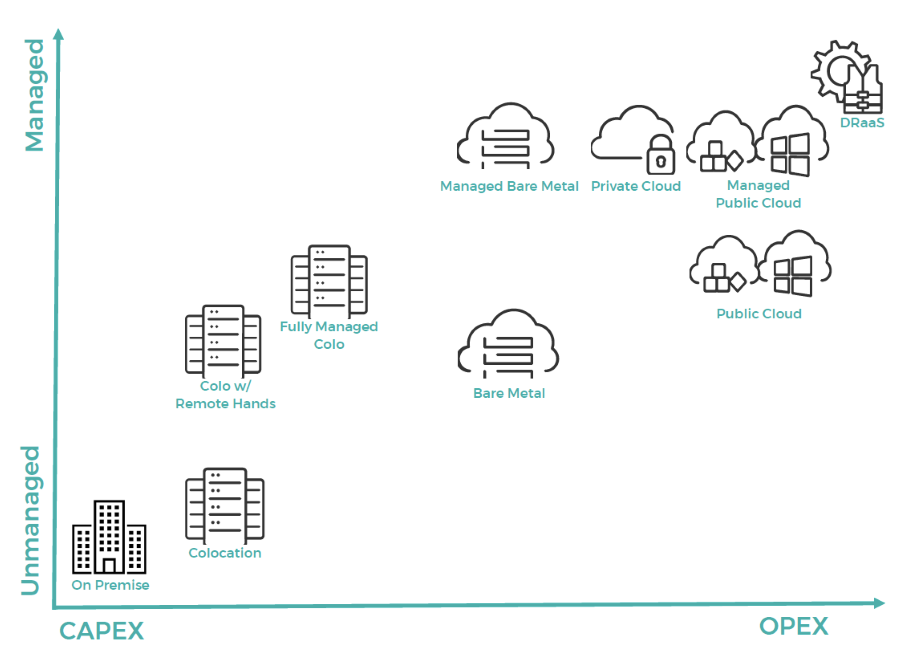
A Simple Guide for Choosing the Right Hybrid IT Infrastructure Mix for Your Applications
According to INAP’s latest State of IT Infrastructure Management report, 69 percent of IT professionals say their organization has already adopted a hybrid IT strategy, deploying their infrastructure on more than one platform.
What’s responsible for the growing popularity of hybrid IT? Simply put, a hybrid IT model allows companies to embrace the flexibility of the cloud while maintaining control over resources that might not be best suited for a cloud environment.
In this simple guide, I will:
- Briefly define hybrid IT (and what it’s not)
- Summarize the three most important factors that will shape your hybrid IT mix
- Illustrate how popular infrastructure models—like public cloud and bare metal—can be viewed through the lens of these factors
What is Hybrid IT?
Hybrid IT is an infrastructure model that embraces a combination of on-prem, colocation and cloud-based environments to make up an enterprises’ infrastructure mix. It’s important to note that while hybrid IT can encompass both hybrid cloud (which uses private and public cloud services for a single application) and multicloud (using multiple cloud services for different applications), it is not interchangeable with these terms.
Three Considerations for Shaping Your Hybrid IT Infrastructure Mix
If you’ve thought about making the jump to a hybrid IT model, what factors should you consider for selecting the right infrastructure mix? At the application level, it’s easy to get in the weeds of whether a certain platform or provider will perform better over another. That’s an important process, but it’s not where you want to start your planning.
When I meet with a new customer or prospect to flesh out a hybrid IT strategy, three fundamental topics chart the course of the solution design process: Economics, management rigor and solution flexibility. Let’s break down each into simple questions.
1. Is CAPEX or OPEX spending more optimal for your workloads?
One of cloud computing’s more attractive features is the ability to substitute capital expenditures (CAPEX) for ongoing usage-based operational expenditures (OPEX). It’s likely that OPEX cloud environments will end up covering a sizable chunk of IT workloads in the future, but it will by no means be suitable for all use cases. Adopting a hybrid IT strategy acknowledges that CAPEX intensive models, like on-prem and colocation, will have their place long into the cloud computing era.
To decide whether OPEX or CAPEX is the way to go, analyze the short- and long-term needs of the application.
OPEX addresses the needs of ephemeral workloads that use compute and storage resources sporadically. OPEX models are also advantageous for new applications or services where steady state usage levels are yet to be determined.
When provisioning constant workloads for the long term, however, it’s generally more cost-effective to use CAPEX over OPEX, as the investment would be amortized over the time period it is used or planned for (typically 3 or 5 years).
2. How much time do you want to put into managing your infrastructure solutions?
To determine whether managed or unmanaged solutions are a better fit for your company, think about how much time the IT department has to spend handling the day-to-day upkeep of the infrastructure. Consider this: Of the 500 IT pros we interviewed for the aforementioned State of IT Infrastructure Management report, 59 percent of participants said they are frustrated by the time spent on routine infrastructure activities and 84 percent agreed that they “could bring more value to their organization if they spent less time on routine tasks”.
Depending on how much an enterprise expects its IT team to move the needle forward for the business, managed solutions might be the best fit. In addition, some businesses may have special requirements to address, such as security or compliance, which require outside help from service providers who have expertise in handling and addressing those needs.
3. How important is solution flexibility?
Workload characteristics may change over time. Services and applications might need to be adjusted or completely discontinued due to changes in business priorities or merger and acquisition events. Changes in IT leadership and decision makers may shift the focus and priorities, or if a newly launched service is unexpectedly more popular in some geographical areas, it may in turn require shifting resources and focus for the IT team.
When such unforeseen events happen, unplanned changes to the IT environment will follow suit. As such, it’s important to have a trusted service provider who can help you successfully navigate these changes.
Spend portability allows you to shift spending or investments from existing contracted services to other service offerings while staying at the same level of spend. For instance, expenses on contracted colocation services may need to shift to bare metal or private cloud solutions based on changing workload needs. To help customers adapt their infrastructure to new requirements and unexpected adjustments, we at HorizonIQ launched the industry’s first formal spend portability program, HorizonIQ Interchange, for new colocation or cloud customers.
No matter what provider you choose to partner with, ensure you have flexibility for those unforeseen future changes to your business.
Choosing a Best-Fit Infrastructure Mix to Manage Change and Application Lifecycles
Now that you’ve thought about the best budgetary, management models and flexibility you’ll need for your applications and workloads, let’s consider the most common infrastructure deployment models and how they speak to each consideration.
The following graph plots each type of environment along an X-Y axis. The environments further to the right adhere more closely to an OPEX model, and those plotted higher mean less of the infrastructure management burden falls to the customer.
It’s likely your hybrid IT mix will end up utilizing several of these options, depending on your application stack. For hybrid cloud use cases, many of these environments may be interconnected, as well.

-
On-Premise
Still is the locale for a substantial amount of IT workloads and applications. With a few exceptions, these are almost always fully managed in-house and fall on the CAPEX side of the spectrum.
-
Colocation
Typically offers space, power, and physical security within a reliable data center facility. It may be augmented with remote hands (RH) offerings but can also be extended to a fully managed colo environment by the data center provider or other third-party vendors.
-
Private cloud
Usually consists of managed physical and virtual hosts, managed network, storage and security in a dedicated environment. The offering can be extended with more premium managed services such as database administration, threat management and IDS/IPS, app monitoring, compliance enablement, or even to a fully managed solution by the service provider.
-
Public cloud
Tends to be an unmanaged offering, though it can be enhanced with additional managed services such as monitoring, security, backup, and disaster recovery services. For organizations interested in using the public could such as AWS, Azure, and GCP, but have no expertise in deploying or managing workloads in such environments, a managed public cloud service may be helpful. It can cover any level of engagement from the initial design and deployment to comprehensive daily management of the cloud environment.
Similar to public cloud on the IaaS level, bare metal also tends to be unmanaged, but can easily be augmented by premium managed services and monitoring. Compared to multitenant cloud, bare metal typically provides greater performance while being more cost-effective, making it a destination for those moving away from public cloud for cost or performance reasons.
Closing Thoughts
Are you ready to embrace a hybrid IT strategy? Or do you want to review your current strategy? As you reflect on the considerations and solutions outlined in this blog, know that you can reach out to our experts at HorizonIQ. We’re here to discuss the best-fit solutions for your company. Check out our locations or chat now to get in touch.



